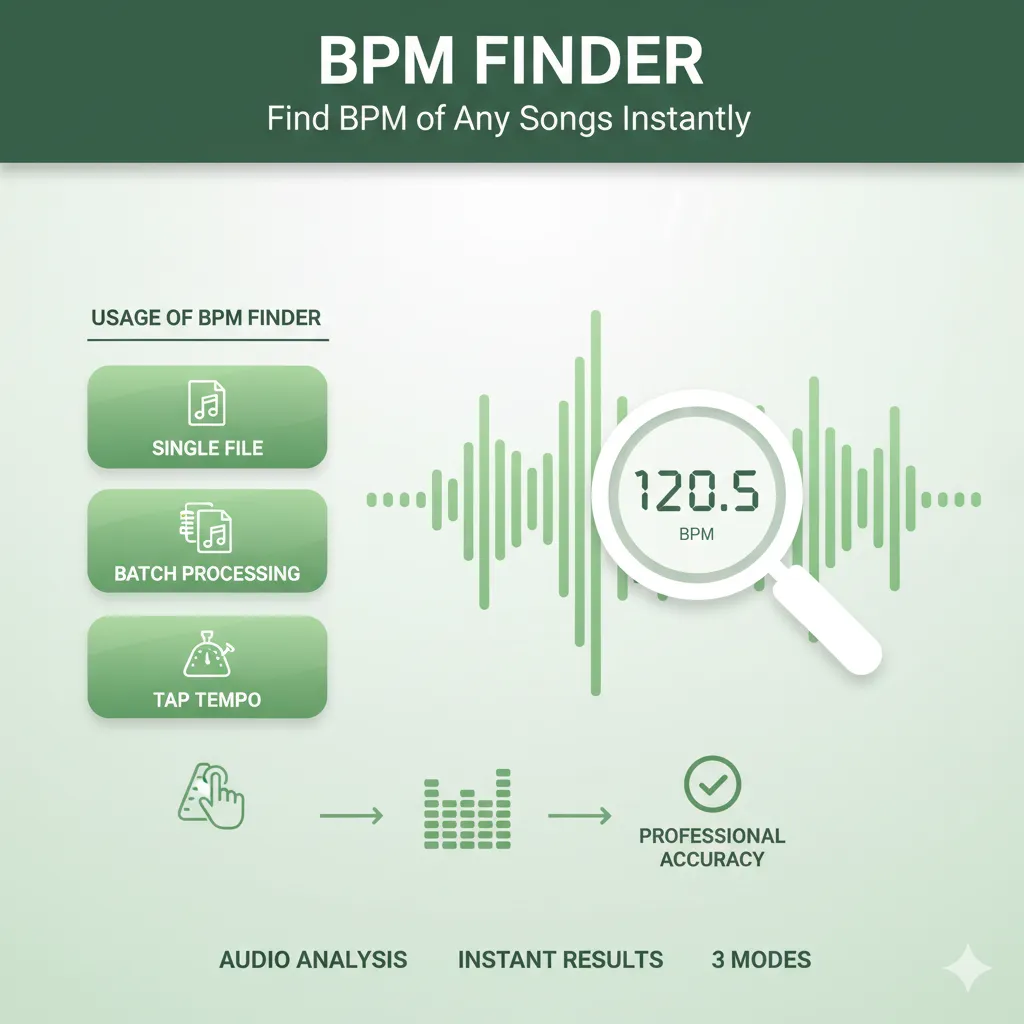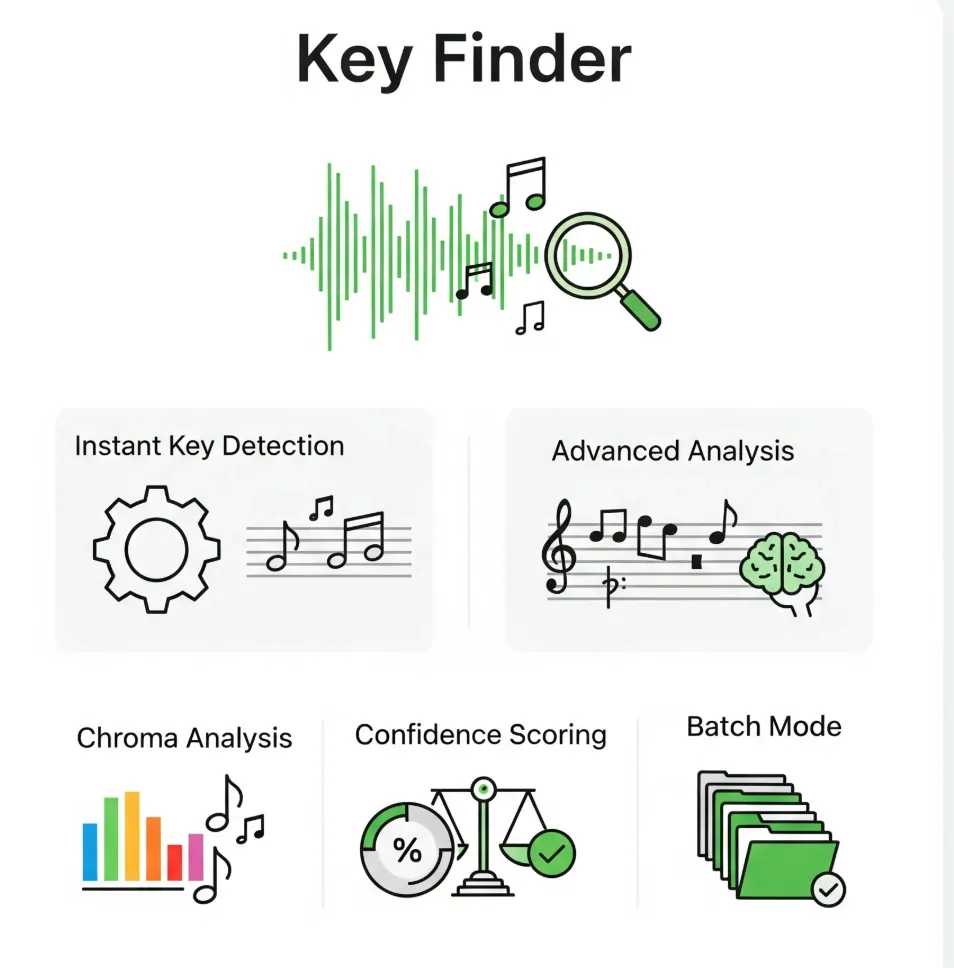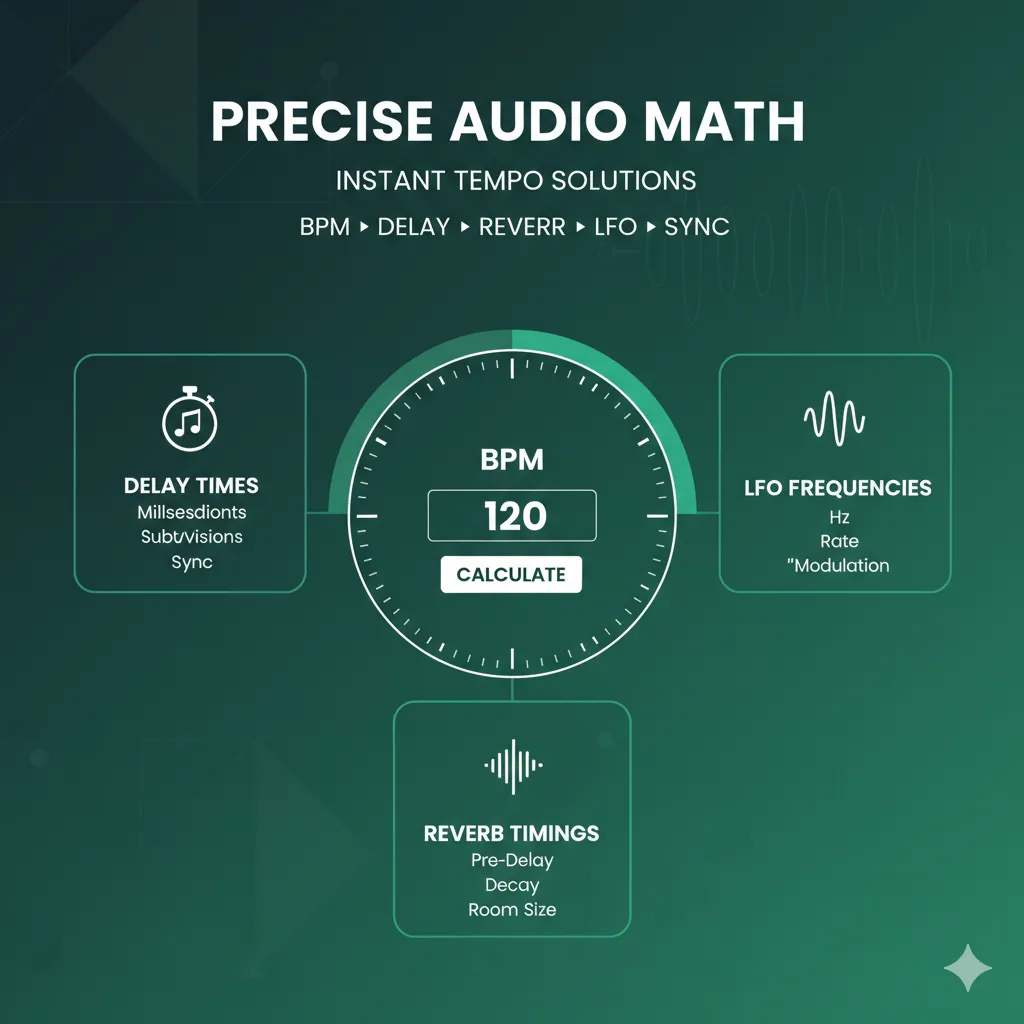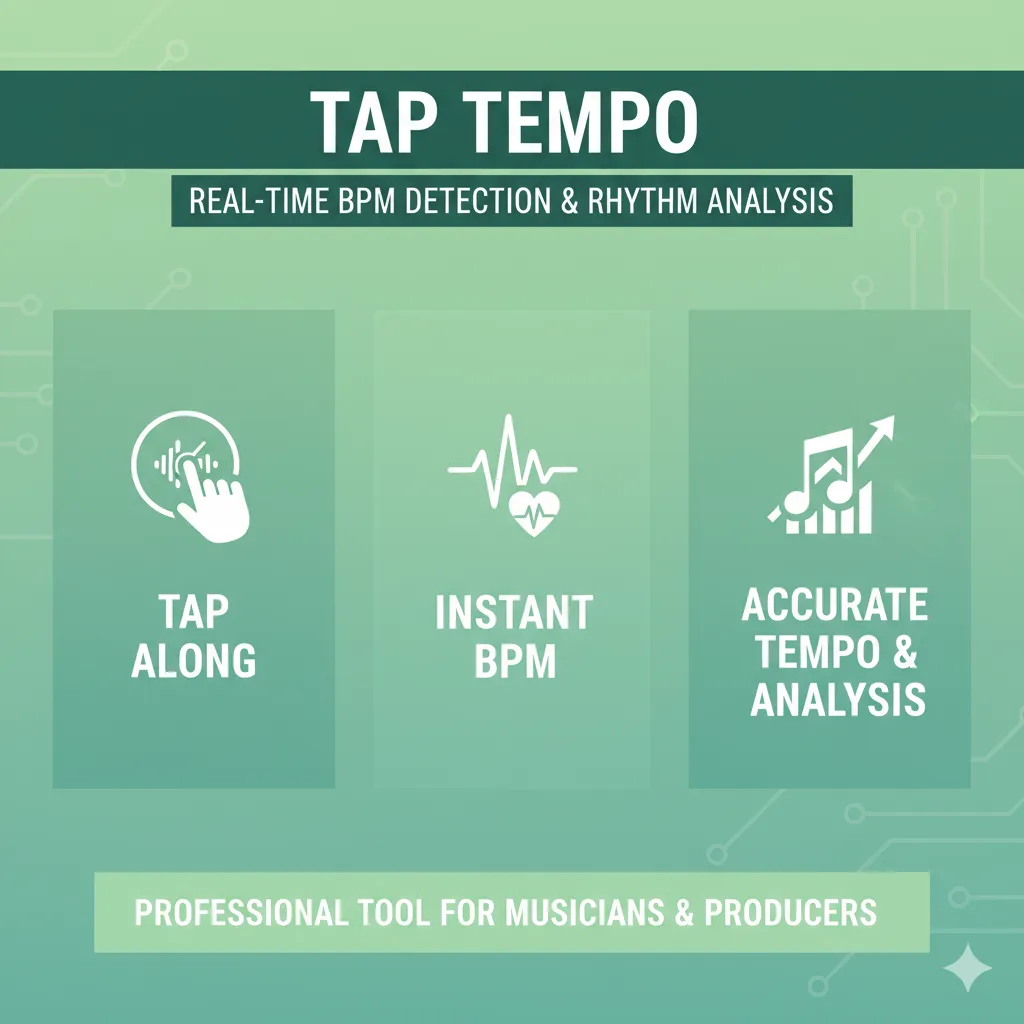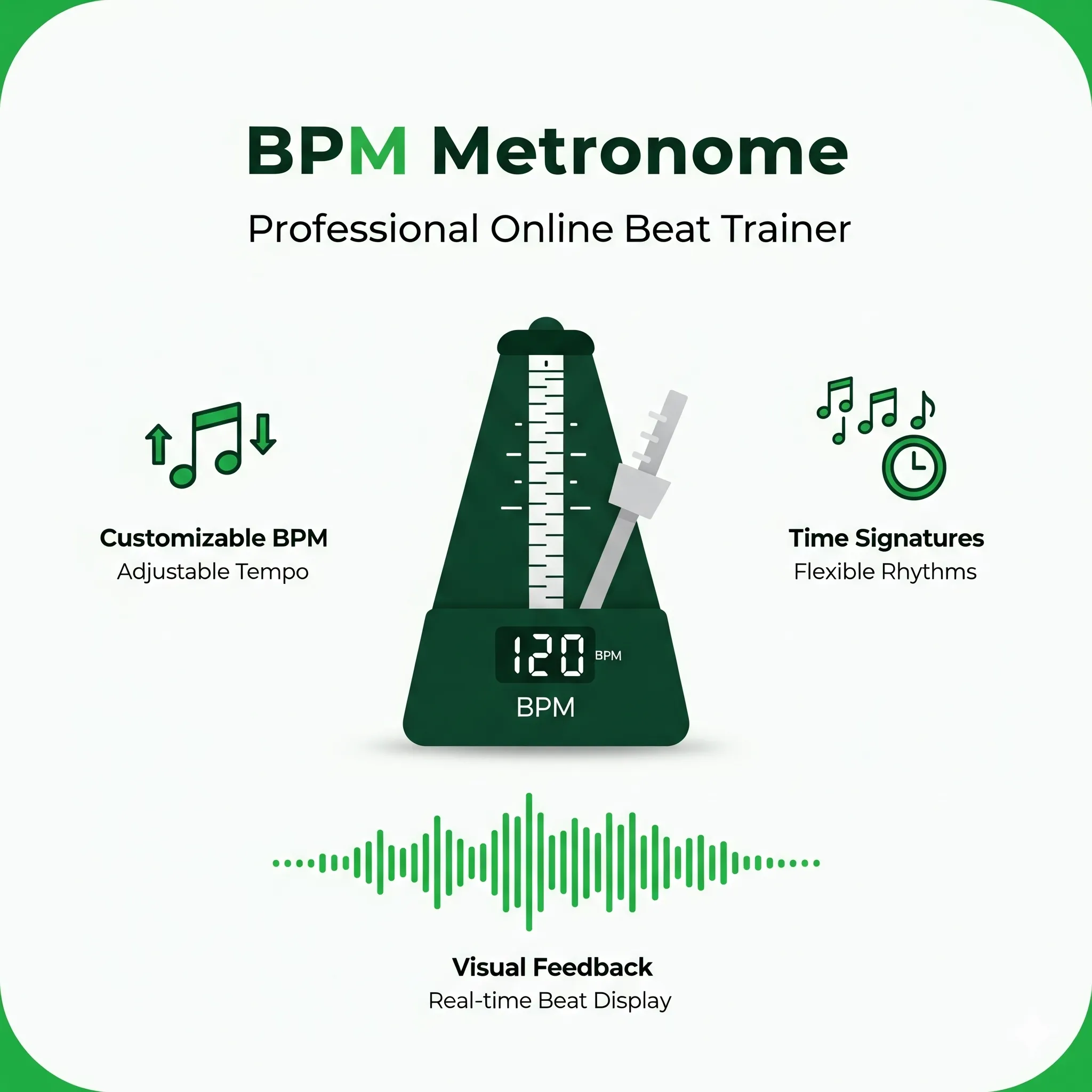- BPM Finder Blog
- How Many BPM is Normal? Complete Heart Rate Guide for All
How Many BPM is Normal? Complete Heart Rate Guide for All

How Many BPM is Normal? Complete Heart Rate Guide for All Ages
When you check your heart rate and see a number flashing on your fitness tracker or feel the rhythm of your pulse, one question naturally arises: how many BPM is normal? Understanding what constitutes a normal heart rate is crucial for monitoring your cardiovascular health, whether you're an athlete tracking performance, a parent checking on your child, or simply someone interested in maintaining optimal wellness.
The short answer: for adults aged 15 and older, a normal resting heart rate ranges from 60 to 100 beats per minute (BPM). However, this is just the beginning of the story. Your age, fitness level, overall health, and even the time of day all play critical roles in determining what's truly "normal" for you. In this comprehensive guide, we'll explore everything you need to know about normal BPM, from newborns to seniors, and help you understand when your heart rate numbers should raise concern.
Quick Answer: Normal BPM by Age
Let's start with the most important information—how many BPM is normal for different age groups. These ranges represent resting heart rate, meaning measurements taken when you're calm, seated or lying down, and haven't been active recently.
| Age Group | Normal Resting Heart Rate (BPM) |
|---|---|
| Newborn (0-1 month) | 100-160 |
| Infant (0-3 months) | 70-170 |
| Infant (6-12 months) | 80-140 |
| Toddler (1-3 years) | 80-130 |
| Preschooler (3-5 years) | 80-120 |
| School-Age (6-10 years) | 70-110 |
| Pre-Teen (11-14 years) | 60-105 |
| Teen & Adult (15+ years) | 60-100 |
| Well-Trained Athletes | 40-60 |
As you can see, normal BPM varies significantly with age. Newborns have the fastest heart rates, sometimes reaching 160 BPM, while their hearts work overtime to support rapid growth and development. As children mature, their cardiovascular systems become more efficient, and heart rates gradually decrease until reaching adult levels around age 15.
Understanding BPM: What Does It Really Mean?
BPM stands for "beats per minute"—a measurement of how many times your heart contracts to pump blood throughout your body in 60 seconds. Whether you're measuring your heart rate or analyzing music tempo, understanding BPM is essential. Every heartbeat is orchestrated by a sophisticated electrical system within your heart, beginning at a specialized cluster of cells called the sinoatrial (SA) node, often referred to as your heart's natural pacemaker.
This SA node spontaneously generates electrical impulses that spread across your heart's chambers, triggering the coordinated muscle contractions that produce each heartbeat. Without any external influence, the SA node would fire at approximately 100 BPM. However, your parasympathetic nervous system acts as a natural "brake," slowing your resting heart rate to the typical 60-100 BPM range seen in healthy adults.
Resting Heart Rate vs. Active Heart Rate
When we discuss how many BPM is normal, we're typically referring to your resting heart rate (RHR)—the baseline measurement taken when your body is at complete rest. This is distinctly different from your heart rate during physical activity, which can reach 150-200 BPM or higher depending on exercise intensity and your maximum heart rate.
Your resting heart rate serves as a fundamental vital sign that healthcare providers use to assess cardiovascular health. A lower RHR generally indicates a more efficient heart that doesn't have to work as hard to maintain circulation, which is why well-conditioned athletes often have resting heart rates between 40-60 BPM.
Normal BPM by Age: A Detailed Breakdown
Understanding how many BPM is normal requires recognizing that heart rate changes dramatically throughout the lifespan. Let's explore why these age-specific variations exist and what they mean for cardiovascular health.
Newborns and Infants (0-12 Months)
Newborn babies have exceptionally high heart rates, with normal ranges spanning from 70 to 170 BPM depending on their exact age. A newborn's heart rate of 160 BPM might alarm an adult, but it's perfectly healthy for an infant.
Why do babies have such fast heart rates? Their small hearts must beat more frequently to circulate blood throughout their rapidly growing bodies. Additionally, their cardiovascular systems are still developing and haven't yet achieved the efficiency of an adult heart. The metabolic demands of growth require substantial oxygen delivery, necessitating a faster heart rate.
Children and Adolescents (1-14 Years)
As children grow, their hearts become larger and more efficient, gradually reducing the necessary heart rate. A toddler's normal BPM ranges from 80-130, while school-age children typically fall into the 70-110 range. By adolescence (11-14 years), heart rates approach adult norms at 60-105 BPM.
Parents often wonder how many BPM is normal for their children and worry when they see numbers that would be concerning in adults. Remember that what's normal is age-dependent—a 5-year-old with an 85 BPM heart rate is in the normal range, even though this would be considered slightly elevated for a sedentary adult.
Adults (15 Years and Older)
For the vast majority of adults, a normal resting heart rate falls between 60 and 100 BPM. This range is endorsed by major medical authorities including the American Heart Association, Mayo Clinic, and Cleveland Clinic. However, within this range, lower is generally better when it comes to cardiovascular efficiency.
A well-conditioned heart with strong muscle tissue can pump more blood with each contraction (higher stroke volume), meaning it needs fewer beats per minute to maintain adequate circulation. This is why fitness level dramatically impacts where you fall within the normal range.
Athletes and Highly Fit Individuals
Endurance athletes and very fit individuals often have resting heart rates between 40-60 BPM, a condition known as athletic bradycardia. This isn't cause for concern—it's actually a sign of superior cardiovascular conditioning. The heart has adapted to regular training by becoming stronger and more efficient, requiring fewer beats to accomplish the same work.
Tour de France cyclists, Olympic swimmers, and marathon runners commonly have resting heart rates in the low 40s or even high 30s. If you're not an athlete but have a heart rate below 60 BPM, it's worth consulting with a healthcare provider to rule out underlying conditions.
What Affects Your Normal BPM?
How many BPM is normal for you specifically depends on numerous individual factors beyond just age. Understanding these influences helps you interpret your heart rate measurements accurately and avoid unnecessary worry over normal fluctuations.
Fitness Level and Cardiovascular Conditioning
Regular aerobic exercise is one of the most powerful modulators of resting heart rate. When you engage in consistent cardiovascular training—running, cycling, swimming, or brisk walking—your heart muscle strengthens and enlarges. This adaptation allows your heart to pump more blood with each contraction, reducing the frequency of beats needed at rest.
Studies show that just 6-8 weeks of regular aerobic exercise can lower resting heart rate by 5-10 BPM in previously sedentary individuals. The effect is dose-dependent: more exercise generally produces greater reductions, which is why elite athletes have such low resting heart rates.
Emotional and Psychological States
Your mind and heart are intimately connected. Stress, anxiety, excitement, anger, and fear all trigger your sympathetic nervous system's "fight-or-flight" response, releasing hormones like epinephrine (adrenaline) that increase heart rate. This is why how many BPM is normal can vary throughout your day based on your emotional state.
Conversely, relaxation techniques like meditation, deep breathing exercises, yoga, and progressive muscle relaxation activate your parasympathetic nervous system, slowing your heart rate. Regular practice of stress management techniques can lower your baseline resting heart rate over time.
Environmental Factors
Your surroundings significantly impact heart rate:
Temperature and Humidity: In hot or humid conditions, your body works harder to dissipate heat by pumping more blood to your skin's surface. This can raise your resting heart rate by 5-10 BPM or more. High humidity is particularly taxing because sweat evaporation (your body's primary cooling mechanism) becomes less efficient.
Altitude: At higher elevations where oxygen is less abundant, your heart must beat faster to deliver adequate oxygen to tissues. This effect is most pronounced in the first few days at altitude before acclimatization occurs.
Body Position: Your heart rate changes with posture. Moving from lying down to standing typically causes a temporary increase of 10-15 BPM as your cardiovascular system adjusts to gravity's effects on blood distribution.
Medications and Substances
Many medications directly affect heart rate:
Beta-blockers (prescribed for high blood pressure, heart conditions, and anxiety) intentionally slow heart rate by blocking adrenaline's effects. If you're taking these medications, a heart rate of 50-60 BPM might be your normal.
Thyroid medications, certain asthma inhalers, and some decongestants can increase heart rate. Stimulants like caffeine and nicotine temporarily elevate heart rate by stimulating your sympathetic nervous system. A single cup of coffee can raise heart rate by 5-10 BPM for 2-3 hours.
Hydration Status
Dehydration has a profound effect on heart rate. When you're dehydrated, blood volume decreases and blood becomes more viscous (thicker). Your heart must work harder and beat faster to circulate this thicker blood throughout your body. Even mild dehydration (as little as 1-2% body weight loss) can elevate resting heart rate by 5-10 BPM.
Sleep Quality
Heart rate naturally slows during sleep, sometimes dropping to 40-50 BPM in healthy adults. Poor sleep quality, sleep deprivation, or sleep disorders like sleep apnea disrupt this pattern and can result in elevated daytime resting heart rate. Consistently getting 7-9 hours of quality sleep helps maintain a healthy heart rate.
Gender Differences
On average, adult women have slightly higher resting heart rates than men—typically 78-82 BPM for women compared to 70-72 BPM for men. This difference is primarily anatomical: after puberty, male hearts grow 15-30% larger than female hearts. To achieve the same cardiac output (blood volume pumped per minute), the smaller female heart must beat more frequently.
How to Measure Your Heart Rate Accurately
To truly answer how many BPM is normal for you, you need to measure your heart rate correctly. Inaccurate measurements can lead to unnecessary worry or missed warning signs.
Best Time to Measure Resting Heart Rate
For the most accurate resting heart rate measurement:
- First thing in the morning before getting out of bed is ideal
- After sitting quietly for at least 5-10 minutes
- Avoid measuring within 2 hours of exercise, consuming caffeine, or stressful events
- Don't measure when you're ill, as fever and infection elevate heart rate
Manual Pulse Measurement Method
You can easily check your pulse manually at two primary locations. If you prefer a more interactive approach, you can also use our tap tempo tool to measure your heart rate in real-time by tapping along with your pulse:
Wrist (Radial Pulse):
- Turn one hand palm-up
- Place the index and middle fingers of your other hand on the inside of your wrist, in the groove on the thumb side
- Press gently until you feel a consistent beat
- Count the beats for 60 seconds (or count for 30 seconds and multiply by 2)
Neck (Carotid Pulse):
- Place your index and middle fingers gently on the soft hollow beside your windpipe
- Press very gently—never press hard on both sides of your neck simultaneously, as this can restrict blood flow to your brain
- Count beats for 60 seconds
Important: Always use your fingers, never your thumb, which has its own pulse that can confuse your count.
Wearable Heart Rate Monitors
Modern fitness trackers and smartwatches have made continuous heart rate monitoring accessible to everyone. Most wrist-based devices use photoplethysmography (PPG)—they shine LED light onto your skin and detect changes in light reflection caused by blood pulsing through capillaries.
Accuracy Considerations:
- Most optical sensors are highly accurate for resting heart rate measurements
- Accuracy can decrease during intense exercise, especially with excessive arm movement
- Chest strap monitors that detect electrical signals (like ECGs) are generally more accurate during vigorous activity
- Accuracy varies by brand—research suggests Apple Watch and Garmin devices show high reliability
The greatest value of wearables isn't necessarily the precision of a single reading, but rather the ability to track trends over time. Monitoring your heart rate patterns across days, weeks, and months provides valuable insights into your cardiovascular health and fitness progress.
When to Be Concerned: Abnormal Heart Rates
While we've established how many BPM is normal, it's equally important to recognize when heart rate indicates a potential problem. The context matters tremendously—it's not just about the number, but also how you feel.
Tachycardia: When Your Heart Beats Too Fast
Tachycardia is defined as a resting heart rate consistently above 100 BPM. It's crucial to distinguish between sinus tachycardia (a normal response to exercise, stress, fever, or dehydration) and cardiac arrhythmias (where fast heartbeat results from electrical system problems).
Concerning symptoms that may accompany tachycardia:
- Palpitations (feeling your heart racing, pounding, or fluttering)
- Chest pain or discomfort
- Shortness of breath at rest
- Dizziness or lightheadedness
- Fainting or near-fainting episodes
If you experience a resting heart rate above 100 BPM accompanied by any of these symptoms, seek immediate medical attention. Even without symptoms, persistently elevated resting heart rate warrants a medical evaluation.
Bradycardia: When Your Heart Beats Too Slowly
Bradycardia is defined as a resting heart rate below 60 BPM. For athletes and highly fit individuals, this is often perfectly normal and healthy. However, for people who aren't regularly active, bradycardia may signal:
- Heart electrical system problems (sinus node dysfunction or heart block)
- Medication side effects
- Hypothyroidism (underactive thyroid)
- Damage from heart attack or heart disease
Concerning symptoms that may accompany bradycardia:
- Severe fatigue or weakness
- Confusion or memory problems
- Dizziness or lightheadedness
- Fainting spells
- Shortness of breath, especially with exertion
- Rapid tiring during physical activity
When to Seek Medical Care
Schedule a non-urgent appointment with your healthcare provider if:
- Your resting heart rate is consistently above 100 BPM
- Your resting heart rate is consistently below 60 BPM and you're not a trained athlete
- You notice a sudden, sustained change in your typical heart rate pattern
Seek IMMEDIATE medical attention if abnormal heart rate is accompanied by:
- Fainting or near-fainting
- Severe dizziness
- Shortness of breath at rest
- Chest pain or pressure
- Heart palpitations or sensation of skipped beats
Remember: your body's ability to tolerate a given heart rate is what matters most. An abnormal number without symptoms warrants evaluation, but an abnormal number with concerning symptoms may constitute a medical emergency.
Exercise and Heart Rate: Beyond Resting BPM
While understanding how many BPM is normal at rest is crucial, your heart rate response to exercise provides additional insight into cardiovascular health and fitness.
Maximum Heart Rate
Your maximum heart rate (MHR) is the highest number of beats your heart can achieve during maximal exertion. While the traditional "220 minus age" formula is widely known, more accurate equations exist:
- Tanaka Formula: 208 - (0.7 × age)
- Gulati Formula (for women): 206 - (0.88 × age)
For a 40-year-old, the Tanaka formula estimates MHR at 180 BPM, while traditional formula suggests the same.
Target Heart Rate Zones
For effective aerobic exercise that improves cardiovascular health:
Moderate Intensity: 50-70% of maximum heart rate Vigorous Intensity: 70-85% of maximum heart rate
For example, a 40-year-old with an estimated MHR of 180 should aim for:
- Moderate zone: 90-126 BPM
- Vigorous zone: 126-153 BPM
Regular aerobic exercise in these zones strengthens your heart, improves efficiency, and lowers resting heart rate over time. This is one of the most effective ways to optimize how many BPM is normal for you specifically—by improving cardiovascular fitness, you naturally shift toward the lower, healthier end of the normal range.
Tips for Maintaining a Healthy Heart Rate
Understanding how many BPM is normal empowers you to take action to maintain healthy cardiovascular function:
1. Engage in Regular Aerobic Exercise
Aim for at least 150 minutes of moderate-intensity or 75 minutes of vigorous-intensity aerobic activity weekly. Activities like brisk walking, jogging, cycling, swimming, and dancing all strengthen your heart and lower resting heart rate. To maintain proper pacing during workouts, consider using an online metronome to keep a steady rhythm that matches your target heart rate zone.
2. Practice Stress Management
Chronic stress keeps your sympathetic nervous system activated, maintaining elevated heart rate. Incorporate daily relaxation practices:
- Deep breathing exercises (try box breathing: inhale 4 counts, hold 4, exhale 4, hold 4)
- Meditation or mindfulness practice
- Yoga or tai chi
- Progressive muscle relaxation
3. Prioritize Quality Sleep
Aim for 7-9 hours of quality sleep per night. Establish a consistent sleep schedule, create a dark and cool sleeping environment, and avoid screens before bedtime. Good sleep allows your heart to rest and recover, maintaining healthy daytime heart rate.
4. Stay Well Hydrated
Drink adequate water throughout the day—general guidelines suggest 8-10 cups daily, though needs vary based on activity level, climate, and individual factors. Proper hydration maintains optimal blood volume and prevents compensatory increases in heart rate.
5. Limit Stimulants
If you notice your heart rate is consistently at the higher end of normal, consider reducing caffeine intake. Be mindful of hidden sources of caffeine in energy drinks, pre-workout supplements, and even some medications.
6. Maintain Healthy Body Weight
Excess body weight places additional demands on your cardiovascular system. Achieving and maintaining a healthy weight through balanced nutrition and regular physical activity helps optimize resting heart rate.
7. Monitor Your Heart Rate Regularly
Establish your personal baseline by checking your resting heart rate regularly—ideally at the same time each day. Track it over weeks and months. A sudden, sustained increase in your typical heart rate (for example, from low 60s to high 80s without clear cause) may indicate an underlying issue warranting medical evaluation. If you're interested in learning more about how to calculate BPM manually or with tools, we have comprehensive guides available.
Conclusion: Know Your Numbers, Know Your Health
So, how many BPM is normal? For adults, the answer is 60-100 BPM at rest, with lower generally indicating better cardiovascular fitness. For children, normal ranges are higher and age-specific. For athletes, 40-60 BPM is common and healthy. But perhaps the most important answer is this: normal is personal.
Understanding your own baseline heart rate and how it responds to various factors—exercise, stress, sleep, hydration—provides invaluable insight into your cardiovascular health. Your heart rate is a dynamic vital sign, constantly adapting to meet your body's changing needs. Rather than fixating on whether a single measurement falls within population norms, focus on knowing your personal patterns and recognizing significant deviations.
By measuring your heart rate regularly, maintaining healthy lifestyle habits, and staying attuned to how you feel, you become an active participant in your cardiovascular health. Remember: an abnormal heart rate accompanied by concerning symptoms always warrants immediate medical attention. When in doubt, consult with a healthcare provider who can evaluate your heart rate in the context of your complete health picture.
Your heart beats approximately 100,000 times per day, pumping 2,000 gallons of blood through 60,000 miles of blood vessels. This remarkable organ deserves your attention and care. Start today by checking your resting heart rate, establishing your baseline, and taking steps to maintain optimal cardiovascular health.
Want to measure your heart rate or analyze your music's BPM? Try our free BPM Finder tool to accurately detect beats per minute in any audio file. You can also explore our other professional tools including key finder for musical analysis and tempo change for adjusting audio speed. For more insights, check out our user reviews to see how others are using these tools for health and music applications.
Works cited
- How the Heart Works - How the Heart Beats | NHLBI, NIH, accessed on October 9, 2025, https://www.nhlbi.nih.gov/health/heart/heart-beats
- Physiology of the Heart - SEER Training Modules - National Cancer Institute, accessed on October 9, 2025, https://training.seer.cancer.gov/anatomy/cardiovascular/heart/physiology.html
- Heart rate - Wikipedia, accessed on October 9, 2025, https://en.wikipedia.org/wiki/Heart_rate
- Normal Heart Rate: Range, When It's Dangerous, and More - Healthline, accessed on October 9, 2025, https://www.healthline.com/health/dangerous-heart-rate
- What is your target heart rate? - Mayo Clinic Health System, accessed on October 9, 2025, https://www.mayoclinichealthsystem.org/hometown-health/speaking-of-health/know-your-numbers-heart-rate
- Heart Rate: Normal Rates & What To Know - Cleveland Clinic, accessed on October 9, 2025, https://my.clevelandclinic.org/health/diagnostics/heart-rate
- Heart Rate | Sports Medicine | UC Davis Health, accessed on October 9, 2025, https://health.ucdavis.edu/sports-medicine/resources/heart-rate
- Pulse Information | Mount Sinai - New York, accessed on October 9, 2025, https://www.mountsinai.org/health-library/tests/pulse
- Analysis of Heart Rate Variability and Implication of Different Factors on Heart Rate Variability - PMC, accessed on October 9, 2025, https://pmc.ncbi.nlm.nih.gov/articles/PMC8950456/
- Update: factors influencing heart rate variability–a narrative review - Frontiers, accessed on October 9, 2025, https://www.frontiersin.org/journals/physiology/articles/10.3389/fphys.2024.1430458/full
- www.heart.org, accessed on October 9, 2025, https://www.heart.org/en/healthy-living/fitness/fitness-basics/target-heart-rates#:~:text=For%20most%20adults%2C%20a%20resting,as%2040%20beats%20per%20minute.
- Heart rate: What's normal? - Mayo Clinic, accessed on October 9, 2025, https://www.mayoclinic.org/healthy-lifestyle/fitness/expert-answers/heart-rate/faq-20057979
- Heart rate: What's normal? - Mayo Clinic | Koc University Hospital, accessed on October 9, 2025, https://www.kuh.ku.edu.tr/mayo-clinic-care-network/mayo-clinic-health-information-library/faqs/heart-rate-what-s-normal
- Resting Pulse Rate Reference Data for Children, Adolescents, and Adults: United States, 1999–2008 - CDC, accessed on October 9, 2025, https://www.cdc.gov/nchs/data/nhsr/nhsr041.pdf
- Heart Rate by Age and Gender | What's the Norm - Welltory, accessed on October 9, 2025, https://welltory.com/heart-rate-by-age-and-gender/
- Women and Heart Rate: What's Normal & What Impacts It, accessed on October 9, 2025, https://my.clevelandclinic.org/health/articles/17644-women-and-heart-rate
- Gender- and age-related differences in heart rate dynamics: are women more complex than men? - PubMed, accessed on October 9, 2025, https://pubmed.ncbi.nlm.nih.gov/7963118/
- The factors that raise and lower your heart rate - Parkview Health, accessed on October 9, 2025, https://www.parkview.com/blog/the-factors-that-raise-and-lower-your-heart-rate
- Factors Affecting Your Heart Rate - Gallagher Fitness Resources, accessed on October 9, 2025, https://activesalem.com/factors-affecting-heart-rate/
- Pulse: What It Is and How To Check - Cleveland Clinic, accessed on October 9, 2025, https://my.clevelandclinic.org/health/articles/23918-how-to-take-your-pulse
- How to check your pulse - Heart Health - BHF, accessed on October 9, 2025, https://www.bhf.org.uk/informationsupport/tests/checking-your-pulse
- Bradycardia - Symptoms and causes - Mayo Clinic, accessed on October 9, 2025, https://www.mayoclinic.org/diseases-conditions/bradycardia/symptoms-causes/syc-20355474
- Maximum Heart Rate Calculator - NTNU, accessed on October 9, 2025, https://www.ntnu.edu/cerg/hrmax
- Why the (220 − Age) formula is outdated, and what to use instead, accessed on October 9, 2025, https://kfitnesslb.com/blog/f/why-the-220-%E2%88%92-age-formula-is-outdated-and-what-to-use-instead
- Target Heart Rates Chart | American Heart Association, accessed on October 9, 2025, https://www.heart.org/en/healthy-living/fitness/fitness-basics/target-heart-rates
- Exercise intensity: How to measure it - Mayo Clinic, accessed on October 9, 2025, https://www.mayoclinic.org/healthy-lifestyle/fitness/in-depth/exercise-intensity/art-20046887
- Target Heart Rate Calculator, accessed on October 9, 2025, https://www.heartonline.org.au/resources/calculators/target-heart-rate-calculator
- Tachycardia: Fast Heart Rate - American Heart Association, accessed on October 9, 2025, https://www.heart.org/en/health-topics/arrhythmia/about-arrhythmia/tachycardia--fast-heart-rate
- Tachycardia - Symptoms and causes - Mayo Clinic, accessed on October 9, 2025, https://www.mayoclinic.org/diseases-conditions/tachycardia/symptoms-causes/syc-20355127
- Bradycardia: Slow Heart Rate | American Heart Association, accessed on October 9, 2025, https://www.heart.org/en/health-topics/arrhythmia/about-arrhythmia/bradycardia--slow-heart-rate
- Know your numbers: Heart rate - Mayo Clinic Health System - YouTube, accessed on October 9, 2025, https://www.youtube.com/watch?v=0P0aNwLbnV0
- How to Check Your Heart Rate | Mass General Brigham, accessed on October 9, 2025, https://www.massgeneralbrigham.org/en/about/newsroom/articles/how-to-check-your-heart-rate
- Heart Rate Monitors: How They Work and Accuracy - Cleveland Clinic, accessed on October 9, 2025, https://my.clevelandclinic.org/health/diagnostics/23429-heart-rate-monitor
- Accuracy of wearable heart rate monitors in cardiac rehabilitation - Etiwy, accessed on October 9, 2025, https://cdt.amegroups.org/article/view/25572/24196
- Reliability and Validity of Commercially ... - JMIR mHealth and uHealth, accessed on October 9, 2025, https://mhealth.jmir.org/2020/9/e18694/
- Accuracy of Wearable Heart Rate Monitors - American College of ..., accessed on October 9, 2025, https://www.acc.org/Latest-in-Cardiology/Journal-Scans/2024/03/19/17/24/accuracy-of-wearable-heart
- Reliability and Validity of Commercially Available Wearable Devices for Measuring Steps, Energy Expenditure, and Heart Rate: Systematic Review - PubMed, accessed on October 9, 2025, https://pubmed.ncbi.nlm.nih.gov/32897239/
BPM Finder Blog
BPM Finder tips, tutorials, and guides for creators

pdfzus: Privacy-First PDF Zusammenfügen for Music Creators
Discover pdfzus, a client-side PDF merging tool that protects your contracts, royalty statements, invoices, and other documents. Perfect for DJs, producers, and music professionals who value privacy.
Read More

120 BPM Songs: The Best Tempo for Every Scenario and Mood
Discover the best 120 BPM songs across all genres! From pop hits to electronic anthems, best for dancing, running, and productivity.
Read More

BPM Finder Reviews: What Users & Media Are Saying About Us
Comprehensive collection of user reviews, testimonials, and media coverage of BPM Finder tools. Discover what DJs, producers, and music enthusiasts really think about tempo detection software.
Read More

How to Find BPM of a Song: Producer-Grade Workflow and Tools
Master how to find BPM of a song with tap tempo, apps, DAWs, and advanced analysis techniques DJs and producers trust.
Read More

Running BPM Mastery: 2025 Heart Rate & Cadence Playbook
Master running bpm in 2025 with heart rate science, cadence tuning, and a 15-step action plan backed by lived experience, expert research, and pro tools.
Read More

How Many BPM is Normal? Complete Heart Rate Guide for All
Discover what BPM is normal for adults, children, and athletes. Learn age-specific heart rate ranges, when to worry, and how to measure accurately.
Read More

How to Calculate BPM: Guide to Heart Rate & Music Tempo (2025)
Learn how to calculate BPM for both heart rate and music tempo. Step-by-step methods, tools, and expert tips for accurate BPM measurement.
Read More

Best Tunebat BPM Alternative: 7 Superior Tools in 2025
Discover accurate Tunebat BPM alternatives that solve key detection issues. Compare top tools like bpm-finder.net, Mixed in Key, and more for DJs and producers.
Read More

What Is Lossless Audio? Complete Guide in 2025
Discover what is lossless audio with our comprehensive guide. Learn about FLAC vs ALAC formats, streaming services, equipment requirements.
Read More
Recommended Tools
Discover additional tools to enhance your music production workflow
Recommended Tools
BPM Analyzer
PopularFind the tempo of any song with professional accuracy for DJs and producers.
Key Finder
Detect the musical key of any song with precision for harmonic mixing.
Tempo Change
Change the tempo of any song with professional accuracy for DJs and producers.
Delay & Reverb Calculator
Convert BPM into precise delay timings, dotted and triplet variations, and reverb suggestions.
Tap Tempo
Tap along to any song or rhythm to instantly get accurate BPM measurements.
BPM Metronome
A metronome with customizable BPM, time signatures, as professional beat trainer.
Hover to view • Click to use tools
Tools
Recommended Tools
BPM Analyzer
PopularFind the tempo of any song with professional accuracy for DJs and producers.
Key Finder
Detect the musical key of any song with precision for harmonic mixing.
Tempo Change
Change the tempo of any song with professional accuracy for DJs and producers.
Delay & Reverb Calculator
Convert BPM into precise delay timings, dotted and triplet variations, and reverb suggestions.
Tap Tempo
Tap along to any song or rhythm to instantly get accurate BPM measurements.
BPM Metronome
A metronome with customizable BPM, time signatures, as professional beat trainer.
Touch to toggle • Tap to use tools






